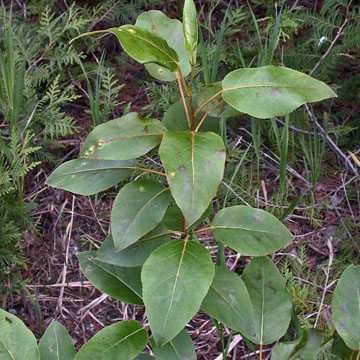

Populus balsamifera - (image 1 of 2)
Taxonomy
Family: Salicaceae
Habitat
Wet woods, river banks, and shores.
Associates
Distribution
Labrador to AK, south to CT, northern PA, northern IN, northern IA, NE, and CO.
Morphology
Deciduous tree to 30 m; bark dark gray and furrowed; twigs glabrous or hairy; terminal buds glabrous, resinous; petioles more or less terete, at least at the base; leaves resinous, ovate to lance-ovate, acute or short-acuminate, finely serrate or subentire, cuneate to rounded or subcordate at the base, glabrous, dark green above, white and glaucous and often streaked with orange resin beneath; scales of the catkins long-ciliate; stamens 20-30; stigmas 2, nearly sessile, broadly dilated; fruits ovoid, 2-valved, 5-8 mm, crowded on short pedicels, forming a compact, spike-like raceme; seeds 15-22 per placenta.
Notes
Flowers early spring
Wetland indicator: FACW
A far north ranging species that can be distinguished from most other poplars by the relatively narrow leaves with nearly terete petioles and orange resinous streaks on the underside of the blade. A rare native hybrid with P. deltoides (P. x jackii) is commonly known as Balm-of-Gilead and sometimes planted as a shade tree.
References
Gleason, Henry A. and A. Cronquist. 1991. Manual of Vascular Plants of Northeastern United States and Adjacent Canada. Second Ed.
The New York Botanical Garden. Bronx, NY
USDA, NRCS. 2002. The PLANTS Database, Version 3.5 (http://plants.usda.gov).
National Plant Data Center, Baton Rouge, LA 70874-4490 USA.
|
Michael Hough © 2018 |